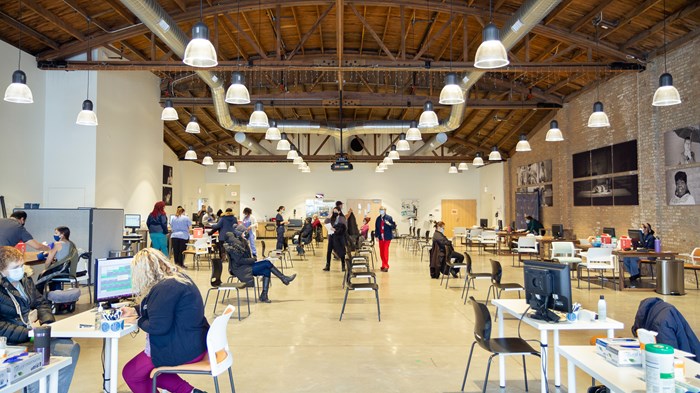
During the COVID-19 pandemic, the US government provided an unusual lifeline to tens of thousands of Christian organizations and churches through forgiven Paycheck Protection Program (PPP) loans under the CARES Act.
That aid amounted to roughly $7 billion in forgiven loans, according to an analysis of federal data by Christianity Today. Most of that funding—about $5 billion—went to churches. Federal aid has gone directly to churches before, in the form of disaster assistance, for example, but rarely at this level.
A new study on the impact of COVID-19 on the American church from Arbor Research Group and ChurchSalary, a ministry of Christianity Today, estimates that slightly more than one-third of all US churches received a PPP loan of some kind. (Almost all of those loans were forgiven, though there were rare instances of churches repaying the federal government.)
The individual loans to Christian organizations ranged from a few hundred dollars to over $10 million. Heritage Christian Services, a Christian organization serving those with disabilities, received one of the largest forgiven loans at about $10 million. Life.Church in Oklahoma received about $7 million.
Some ministries did not seek the aid because they wondered about future conditions attached to it. Steve Smith, the administrative bishop for the New York state Church of God in Christ, told CT that some of his pastors in the state worried there might “be some attachment later on that will have negative effects,” he said.
Early in the pandemic, both Christian financial advisor Dave Ramsey and Crown Financial Ministries’ CEO Chuck Bentley urged churches not to take the PPP money. Ramsey argued it allowed the government into the “management” of churches, which turned out to not be the case in this instance.
A pastor whose church took PPP funding, Mike Vaughn, told CT in 2020 that the program was “a worthwhile exception to the general rule” that his church shouldn’t take money from the government.
The goal of the CARES Act—established during the Trump administration in the early pandemic days of 2020—was to help small businesses and organizations retain staff amid COVID-19 lockdowns. Staff compensation is the largest part of the average church budget, and survey respondents who received PPP aid told ChurchSalary that their churches would have struggled to retain staff without the grants.
The survey by ChurchSalary also showed that for people in ministry who were laid off, more than 40 percent were still looking for similar work in 2023.
Eighty percent of the churches that reported receiving outside financial assistance during the pandemic said it came in the form of a PPP loan. Churches receiving PPP funds tended to be older and larger or were led by older pastors, according to the ChurchSalary study, and tended to be in large cities rather than in rural areas by a wide margin.
The PPP aid is little acknowledged by ministries themselves. Almost no Christian nonprofits returned requests for comment on the aid they received, even when it was in the millions. Some ministries that defied government health orders regarding COVID-19 also took PPP funding.
But a few were happy to share what the aid did for their organizations.
“It helped us out a great deal,” said James Brooks, the CEO of Chicago-based Lawndale Christian Health Center (LCHC), which received $5.6 million in the form of a forgiven loan.
Lawndale serves roughly 70,000 patients a year, most of them Medicaid recipients or uninsured.
Between March 2020 and December 2021, LCHC conducted 41,000 COVID-19 tests. Their staff set up vaccine clinics on the west side of Chicago, and also went door to door with the vaccine.
Though the organization works in health care and remained busy through the pandemic, Brooks said that without the extra PPP support, they would have had to lay off staff who worked on ancillary ministries that were shut down—like a café that the organization runs. Instead, LCHC redirected those people to other roles and new projects.
One new outreach that LCHC staff were able to do was to manage a downtown hotel for 259 unhoused individuals, at the city of Chicago’s request. Lawndale helped those who were high-risk to isolate in the hotel and provided medical care for chronic conditions around the clock. The hotel operation also offered services for substance abuse and mental health.
A 2021 study of Lawndale’s work at the hotel found that the high-risk individuals had a “significant reduction” in contracting COVID-19 compared to those in city shelters, and they had better health indicators like lower hypertension and glycemic control. Most of the participants entered housing upon leaving the hotel.
“Our staff did a wonderful job. It was a hard time, but we saw the hand of God at work,” said Brooks. None of the LCHC staff died from COVID-19. “Every day they came in risking their lives to share the love of Jesus.”
Some legal scholars questioned the validity of the PPP program for religious organizations, calling it “the quiet demise of the separation of church and state.” But no significant constitutional case has moved forward against the aid to religious groups.
The US Small Business Administration, which manages the program, put out a paper explaining why faith-based organizations were eligible for the program, saying that an “otherwise eligible organization” shouldn’t be “disqualified” from loans just for being religious.
Religious recipients noted that the government had ordered the COVID-19 closures of their churches and schools, so it made sense to them that they could receive the same aid that every other closed business (even strip clubs) received.
Stanley Carlson-Thies, the founder of the Institutional Religious Freedom Alliance, argued in an email to CT that the program was clearly constitutional, and “the alternative would have been to single out for disfavored treatment certain religious organizations—like a fire department fights fires in every building except religious facilities.”
The government provides grants to religious organizations for other things like historic preservation, disaster recovery, and protecting buildings (like synagogues) from hate crimes, he noted.
“This kind of equal treatment is well established in constitutional analysis and in federal law, although sometimes new challenges come up and have to be taken on individually,” he said.
PPP loans helped many organizations keep the lights on, but some millions went to organizations that did shutter later—like Alliance University and The King’s College.
Of the governing member schools in the Council for Christian Colleges and Universities (CCCU), more than half received forgiven loans adding up to $174 million in aid. Houston Christian University (formerly Houston Baptist University), for example, received one of the largest amounts at $6.5 million in forgiven loans. The school did not respond to a request for comment.
Organizations with more than 500 employees were not eligible for PPP loans, a rule that excluded CCCU member Union University in Tennessee, for example, from the program.
Christian colleges could also receive PPP loan forgiveness for expenditures to expand remote learning. Philip Dearborn, the president of the Association for Biblical Higher Education (ABHE), a Christian accreditor for about 200 institutions, said he watched ABHE schools take advantage of that.
“The technology they purchased met the immediate COVID-impacted demands and now, post-COVID, is being leveraged to continue developing and expanding delivery methodologies beyond the traditional face-to-face classroom,” he said in an email.
While some schools went remote with their federal funding, organizations like Lawndale became more involved face-to-face with their community through the funding.
Lawndale’s roots are in its neighborhood, having been born out of a neighborhood church, Lawndale Community Church. CEO Brooks’s father and grandfather were both pastors in the community. He lives there, as well as most staff.
“One of our values is proximity,” said Brooks. “That means being close to the pain. We use the John 1:14 text, ‘The Word became flesh and dwelt among us.’ … I like how Eugene Peterson puts it: ‘The Word became flesh … and moved into the neighborhood.’” Even in a pandemic, he said, the ministry was never “remote.”

Support Our Work
Subscribe to CT for less than $4.25/month


















